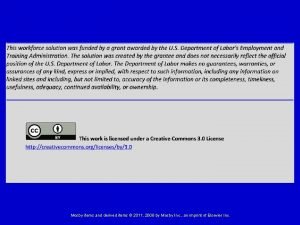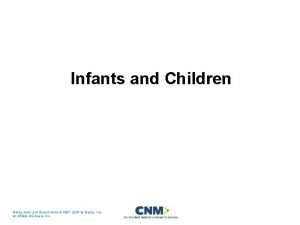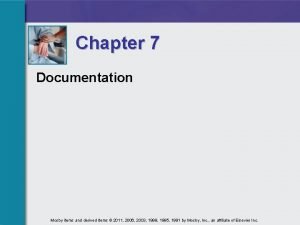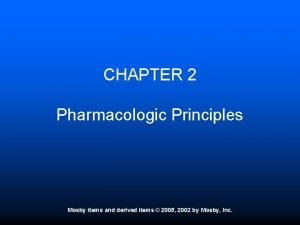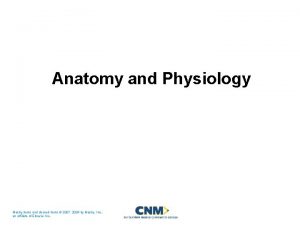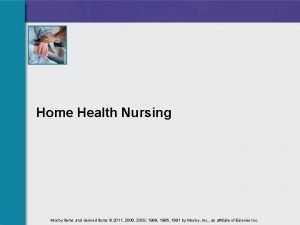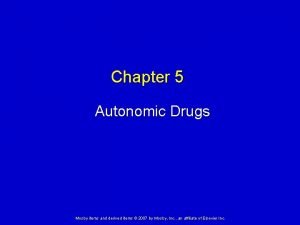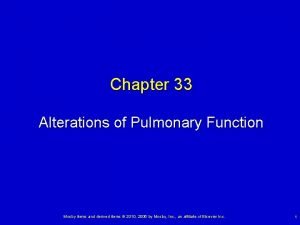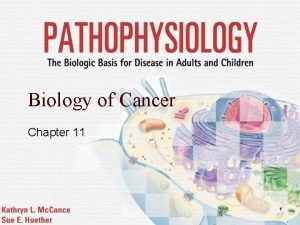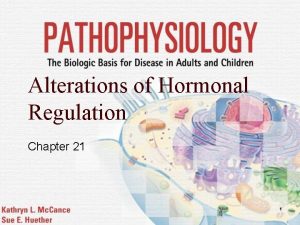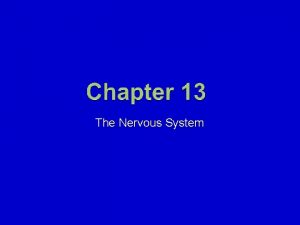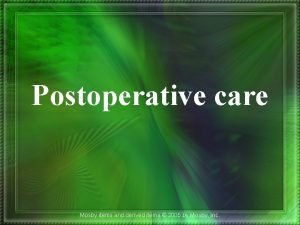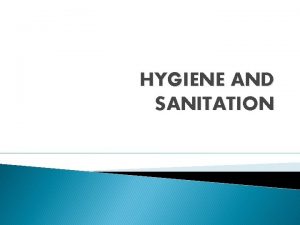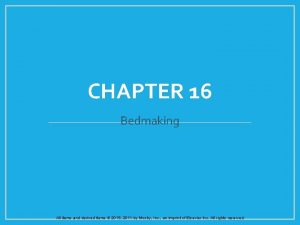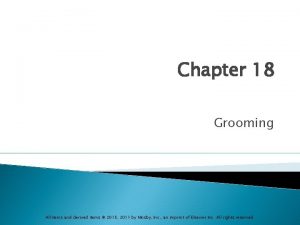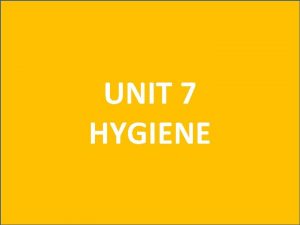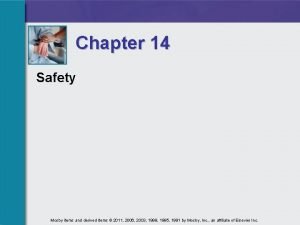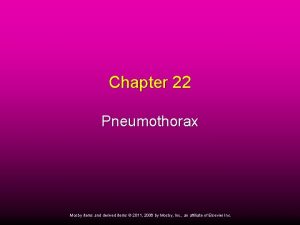CHAPTER 17 Hygiene All items and derived items



















- Slides: 19

CHAPTER 17 Hygiene All items and derived items © 2015, 2011 by Mosby, Inc. , an imprint of Elsevier Inc. All rights reserved.

Hygiene ■ Hygiene promotes comfort, safety, and health. ■ Intact skin: – Is the body’s first line of defense against disease – Prevents microbes from entering the body and causing an infection ■ Good hygiene: – Cleanses the body – Prevents body and breath odors – Is relaxing and increases circulation All items and derived items © 2015, 2011 by Mosby, Inc. , an imprint of Elsevier Inc. All rights reserved. 2

Factors That Affect Hygiene ■ Culture and personal choice affect hygiene. ■ Many factors affect hygiene needs—perspiration, elimination, vomiting, drainage from wounds or body openings, bedrest, and activity. ■ The nurse uses the nursing process to meet the person’s hygiene needs. – Follow the nurse’s directions and the care plan. ■ Some older persons resist your efforts to assist with hygiene. All items and derived items © 2015, 2011 by Mosby, Inc. , an imprint of Elsevier Inc. All rights reserved. 3

Daily Care ■ You must: – Assist with hygiene whenever it is needed. – Protect the person’s right to privacy and to personal choice. ■ Daily care is given at these times: – Before breakfast (early morning care, or AM care) – After breakfast (morning care) – Afternoon care – Evening care (PM care) All items and derived items © 2015, 2011 by Mosby, Inc. , an imprint of Elsevier Inc. All rights reserved. 4

Oral Hygiene ■ Oral hygiene (mouth care) does the following: – Keeps the mouth and teeth clean – Prevents mouth odors and infections – Increases comfort – Makes food taste better – Reduces the risk for cavities (dental caries) and periodontal disease All items and derived items © 2015, 2011 by Mosby, Inc. , an imprint of Elsevier Inc. All rights reserved. 5

Oral Hygiene (Cont’d) ■ Flossing: – Removes plaque and tartar from the teeth ■ Plaque is a thin film that sticks to teeth and causes tooth decay (cavities). When plaque hardens, it is called tartar. Tartar builds up at the gum line and causes periodontal disease. – Removes food from between the teeth – Is usually done after brushing – You need to floss for persons who cannot do so themselves. All items and derived items © 2015, 2011 by Mosby, Inc. , an imprint of Elsevier Inc. All rights reserved. 6

Oral Hygiene (Cont’d) ■ Most people perform oral hygiene themselves. ■ You may need to brush the teeth for persons who: – Are very weak – Cannot move or use their arms – Are too confused to brush their teeth ■ Some people need help gathering and setting up equipment. All items and derived items © 2015, 2011 by Mosby, Inc. , an imprint of Elsevier Inc. All rights reserved. 7

Oral Hygiene Supplies • A toothbrush, toothpaste, dental floss, and mouthwash are needed. • Persons with dentures need a denture cleaner, denture cup, and denture brush or toothbrush. Use only denture cleaning products to avoid damaging dentures. • Sponge swabs are used for persons with sore, tender mouths and for unconscious persons. • You also need a kidney basin, water glass or cup, straw, tissues, towels, and gloves. Many persons bring oral hygiene equipment from home. All items and derived items © 2015, 2011 by Mosby, Inc. , an imprint of Elsevier Inc. All rights reserved. 8

Oral Hygiene for the Unconscious Person ■ Mouth care for the unconscious person – The care plan tells you what cleaning agent to use. – Protect unconscious persons from choking and aspiration. – Keep the person’s mouth open with a padded tongue blade. – Always assume that unconscious persons can hear. – Mouth care is given at least every 2 hours. – Follow the nurse’s directions and the care plan. All items and derived items © 2015, 2011 by Mosby, Inc. , an imprint of Elsevier Inc. All rights reserved. 9

Dentures ■ Denture care – Mouth care is given and dentures cleaned as often as natural teeth. – Dentures are slippery when wet. – Dentures easily break or chip if dropped onto a hard surface. – To use a cleaning agent, follow the manufacturer’s instructions. – Hot water causes dentures to lose their shape (warp). – Remind residents not to wrap dentures in tissues or napkins. – You clean dentures for those who cannot do so. Many people clean their own dentures. Some need help All items and derived items © 2015, 2011 by Mosby, Inc. , an imprint of Elsevier Inc. All rights reserved. 10

Bathing ■ Bathing does the following: – It cleans the skin. – It cleans the mucous membranes of the genital and anal areas. – It is refreshing and relaxing. – Circulation is stimulated and body parts are exercised. – Observations are made. – You have time to talk to the person. ■ Complete or partial baths, tub baths, or showers are given. All items and derived items © 2015, 2011 by Mosby, Inc. , an imprint of Elsevier Inc. All rights reserved. 11

Bathing Factors ■ The bathing method depends on: – The person’s condition – Self-care abilities – Personal choice ■ Bathing frequency is a personal matter. ■ Older persons usually need a complete bath or shower twice a week. ■ Dry skin occurs with aging and is easily damaged. Soap also dries the skin. ■ Bathing procedures can threaten persons with dementia. ■ The complete bed bath involves washing the person’s entire body in bed. All items and derived items © 2015, 2011 by Mosby, Inc. , an imprint of Elsevier Inc. All rights reserved. 12

Towel, Bag, and Partial Baths ■ Towel baths – The nurse and care plan tell you when to use a towel bath. – To give a towel bath, follow center policy. ■ Bag baths – Use a new washcloth for each body part. – Let the skin air-dry. You do not need towels. ■ The partial bath involves bathing the face, hands, axillae, back, buttocks, and perineal area. – You give partial baths to persons who cannot bathe themselves. All items and derived items © 2015, 2011 by Mosby, Inc. , an imprint of Elsevier Inc. All rights reserved. 13

Tubs and Showers ■ Tub baths and showers – Falls, burns, and chilling from water are risks. – Safety is important. – The person’s privacy must be protected. ■ A tub bath can make a person feel faint, weak, or tired. – These are great risks for persons who are on bedrest. – A tub bath lasts no longer than 20 minutes. All items and derived items © 2015, 2011 by Mosby, Inc. , an imprint of Elsevier Inc. All rights reserved. 14

The Back Massage ■ Back massages (back rubs): – Relax muscles and stimulate circulation – Are given after the bath and with evening care – Can be given after repositioning or to help the person relax – Last 3 to 5 minutes ■ Be sure to request a person’s consent before performing a back massage. ■ Observe the skin before the massage. ■ Lotion reduces friction during the massage. – Lotion is warmed before being applied. All items and derived items © 2015, 2011 by Mosby, Inc. , an imprint of Elsevier Inc. All rights reserved. 15

Perineal Care ■ Perineal care (pericare) involves cleaning the genital and anal areas. These areas provide a warm, moist, and dark place for microbes to grow. ■ Cleaning prevents infection and odors, and it promotes comfort. ■ Perineal care is done: – Daily during the bath – Whenever the area is soiled with urine or feces ■ The person does perineal care if able. – Otherwise, it is given by the nursing staff All items and derived items © 2015, 2011 by Mosby, Inc. , an imprint of Elsevier Inc. All rights reserved. 16

Basics of Perineal Care ■ Standard Precautions, medical asepsis, and the Bloodborne Pathogen Standard are followed. – Work from the cleanest area to the dirtiest. ■ The perineal area is delicate and easily injured. – Use warm water, not hot. – Rinse thoroughly. – Pat dry after rinsing. All items and derived items © 2015, 2011 by Mosby, Inc. , an imprint of Elsevier Inc. All rights reserved. 17

Reporting and Recording ■ You make many observations while assisting with hygiene. ■ Report and record the care given. – If care is not recorded, it is assumed that care was not given. All items and derived items © 2015, 2011 by Mosby, Inc. , an imprint of Elsevier Inc. All rights reserved. 18

Quality of Life ■ Provide hygiene in a way that maintains or improves the person’s quality of life, health, and safety. ■ Protect the person’s rights when giving care. – Residents have the right to ■ Privacy and personal choice ■ Freedom from restraint ■ Keep and use personal items All items and derived items © 2015, 2011 by Mosby, Inc. , an imprint of Elsevier Inc. All rights reserved. 19
 Mosby items and derived items
Mosby items and derived items Mosby items and derived items
Mosby items and derived items Acuity charting forms
Acuity charting forms Mosby items and derived items
Mosby items and derived items Mosby items and derived items
Mosby items and derived items Mosby items and derived items
Mosby items and derived items Mosby items and derived items
Mosby items and derived items Mosby items and derived items
Mosby items and derived items Autonomic drugs
Autonomic drugs Mosby items and derived items
Mosby items and derived items Absorptive atelectasis
Absorptive atelectasis Absorption atelectasis
Absorption atelectasis Mosby items and derived items
Mosby items and derived items Mosby items and derived items
Mosby items and derived items Mosby items and derived items
Mosby items and derived items Mosby items and derived items
Mosby items and derived items Mosby items and derived items
Mosby items and derived items Mosby items and derived items
Mosby items and derived items Mosby items and derived items
Mosby items and derived items Mosby items and derived items
Mosby items and derived items
